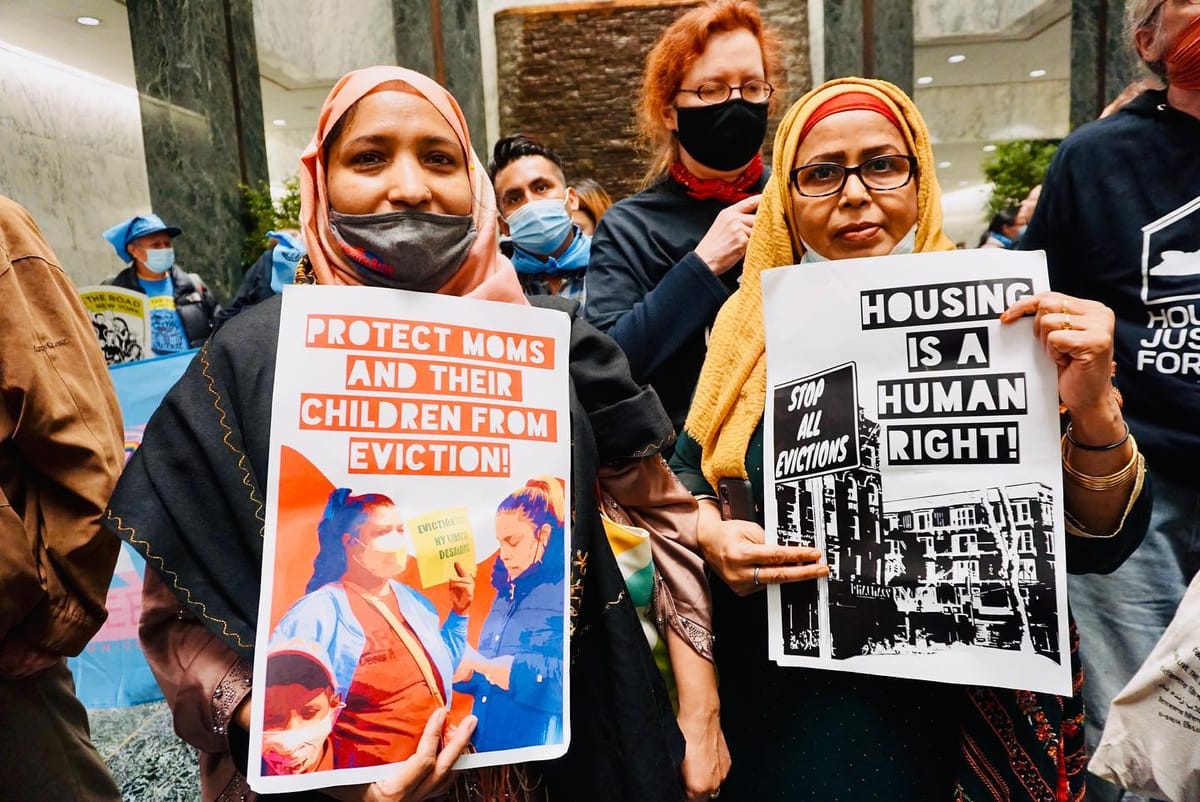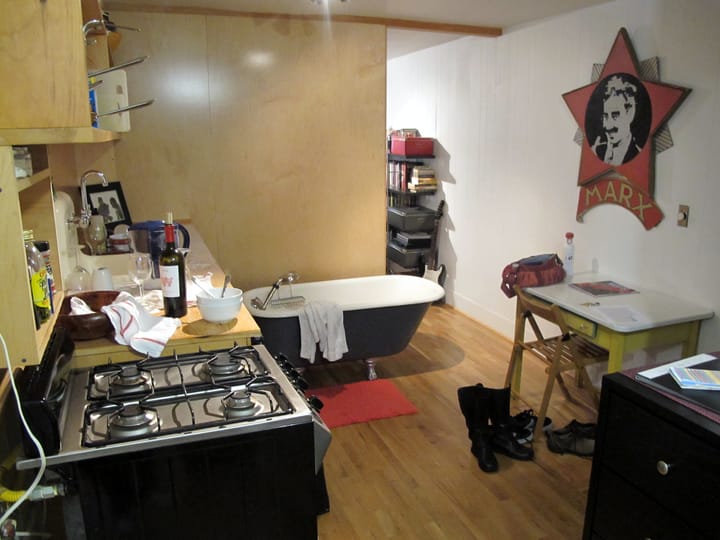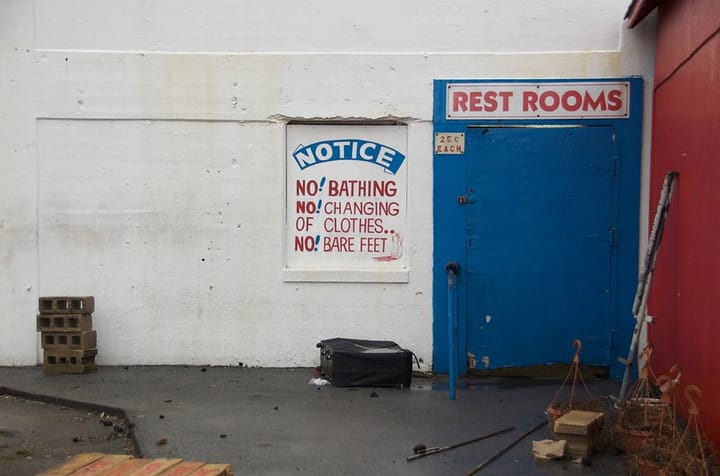How to research your landlord to see if they’re lying about Good Cause Eviction
The state's brand-new renter protections still provide a lot of room for landlord shadiness, so be prepared.

Tenant advocates in Albany went hard this year after what’s known as Good Cause Eviction, a measure heralded as a near cure-all to some of the state’s housing woes. The protections are meant to say that without a “good cause” — missed rent payments or property damage, for example — your landlord shouldn’t be able to kick you out just because some younger and dumber person is willing to pay more for your unit.
It’s a way to push back against “unreasonable” rent increases (defined as more than 10 percent, or 5 percent plus the rate of inflation, whichever is lower) and to allow you to renew your lease without hassle. Proponents say it could stop the insane burn-and-churn cycle of apartment rent hikes that price people out of their homes and the city, and will better allow renters to set down roots in a community without fear that they’re just one broker’s fee away from destitution.
The good news is that a version of this protection did get approved in April’s budget; the bad news is, landlords were able to weasel in a series of complicated exemptions and rules that gut a lot of the power out of the protections — and make others so confusing that we won’t truly know how they break down until they end up in court.
The biggest thing you need to know, however, is how many units your landlord actually owns. If they own 10 or fewer units across the state, they’re considered a “small” landlord and automatically exempt from the law. In that situation, you, the simple renter, get nothing, except the continued questioning about if it’s worth it to fix or paint anything in your apartment ever.
Finding out how many units your landlord has can be tricky, but it is something you need to do right now so you are prepared to protect your new rights. Experts say many cases will end up in court and tenants should be prepared to fight landlords tooth and nail.
“It’s my observation from doing this for decades: every opportunity there is to trick tenants, landlords take,” Ellen Davidson, staff attorney for The Legal Aid Society, told The Groove. In these early days of Good Cause Eviction laws, she said, “I don’t know what form that trickery will take.”
For NYC tenants who *are* now covered by good cause, here's the gist of the (not small) shift:
— Emma Whitford (@emma_a_whitford) April 21, 2024
There used to be no recourse if your LL decided not to renew your tenancy. Now there is. And if they try to up the rent >5%+CPI, 10% max, you can challenge. https://t.co/i5g2YpuYze
A quick-and-dirty guide to whether any of this applies to you
You can narrow down if you’re covered by Good Cause by checking a few quick things (and read a more detailed guide here): if you live in a rent-regulated apartment (those have their own pre-existing protections); in a rental in a condo or co-op building; or any unit built after 2009, you’re not covered. If you already pay more than 245 percent of the fair market rent (see we told you it gets confusing), you’re not covered, according to the law.
If your building was built before 2009 and clearly has more than 10 units in it, you are likely covered. If you live in a building with fewer than 10 units, it gets complicated. And that’s what we’re going to work on now:
Step 1: Who owns your building?
Maybe you know your landlord well, maybe they are just some shadowy person who lives in Connecticut and only mingles with renters when dangling the potential of a rent increase, maybe your building is owned by an LLC shrouded in even more mystery. Step one in this process is figuring out — or confirming — who actually owns your building.
Two tools are available that scrape public data for this info: Who Owns What (created by JustFix, a “technology for housing justice” non-profit) and OpenIgloo. The NYC Department of Finance site also lets you find building info including owners here.
One thing to keep in mind: even a partial owner of a building counts toward the good cause requirements. So for anyone who has their name on your building’s ownership, you can start counting up the other units they own.
Let’s use one address as an example: Dorothy’s address in The Wiz: 433 Prospect Place, which, despite Dorothy saying she lives in Harlem in the movie, is a Brooklyn address. Looking this up on Who Owns What provided no info, but OpenIgloo provided the property owner’s name, information confirmed on the Department of Finance search, along with a second owner name (a quick Google search reveals the two owners are married). Now we’ve got names to work with.
If your building is owned by an LLC, things get trickier. Their names might be hidden. Now here’s where the law — and potential landlord chicanery — comes in. The law requires disclosure of this info: starting in August, the landlord must notify you if you are covered by Good Cause when you are signing or renewing a lease, or if they are raising the rent or trying to evict you. If they claim your building isn’t covered, they must explain why. If the landlord takes you to court, they will be required to disclose every name in the LLC and every building they own.
“If their landlords say they’re small, then tenants should do their homework,” Davidson said. “And figure out whether they think that’s accurate or not.”
Step 2: Do they have a fat enough portfolio?
Now that you have the names, you can track down whether the landlords own any other property, and see if they own, or partially own, more than 10 in total.
You can do this using the city’s Automated City Register Information System, or ACRIS, to see what else they own. This will pull up full city property records past and present (also a neat way to just look at old info, deeds and sale prices of your building). Who Owns What also has a “portfolio” tab that lets you look at what other buildings that landlord owns. The information can be incomplete, so you want to make sure to check other sources too.
For 433 Prospect Place, since nothing came up on Who Owns What to begin with, I took the names I found above and put them into ACRIS to see what else they own. It brought up two properties: 433 Prospect Place, and one other condo. That added up to two units total, and therefore the landlords are exempt from good cause eviction protections. And poor Dorothy could get kicked out whenever her lease is up and the landlord decides to rent to the latest Scarecrow that just landed in Oz.
Step 3: Inform your landlord that you are in possession of receipts
If your landlord is trying to impose the aforementioned “unreasonable” rent increase or evict you, and you have the receipts to prove that Good Cause covers your unit, tell ‘em. And be ready, experts say, to stand your ground on it: if it goes to court, the case could get thrown out in your favor.
Beware of trickery
The law covers tenants across New York state, but outside of New York City, other municipalities will have to opt in. Your landlord might own other properties in other towns, hamlets, upstates and way upstates; that’s harder to track, because tools like Who Owns What and ACRIS only have city data. The building owner might be hiding behind an LLC; but forcing landlords to reveal who is behind the LLC might not be easy.
Who Owns What, for instance, is intended to be “a jumping off point,” said Maxwell Austensen, software engineer for JustFix. But without publicly available ownership information from the city and state, he said, legally verifying every building owned by the same person is hard to accurately list. Some owners may not divulge until they are forced to through a court proceeding, Austensen said— a game of chicken you might have to play with your landlord.
Why is this so complicated?
If it seems like the above tools are not quite prepared for this new law, they’re not! The good cause protections changed form right before they were passed to include these complicated carve outs for landlords, which means the tools are not up to speed yet. Davidson said she expects advocates to create even more detailed and helpful tools for these purposes in the coming months.
“It’s really important that people know there are tools out there that they can start the investigation,” Davidson said. “I imagine all of these tools are going to get better. They are pretty good tools at the moment.”
• ACRIS for detailed NYC property owner data
• Who Owns What for quick property lookups
• OpenIgloo for landlord information and reviews, and a map of rent-stabilized apartments
• JustFix's apartment's rent history request form to see if your unit is stabilized
• City Limits' Good Cause Rent Calculator, an easy way to plug in your rent and see what increase would be considered "reasonable."




Comments ()